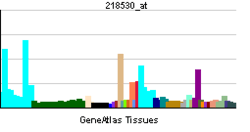FHOD1
FH1/FH2 domain-containing protein 1 is a protein that in humans is encoded by the FHOD1 gene.[2][3][4]
This gene encodes a protein which is a member of the formin/diaphanous family of proteins. The gene is ubiquitously expressed but is found in abundance in the spleen. The encoded protein has sequence homology to diaphanous and formin proteins within the Formin Homology (FH)1 and FH2 domains. It also contains a coiled-coil domain, a collagen-like domain, two nuclear localization signals, and several potential PKC and PKA phosphorylation sites. It is a predominantly cytoplasmic protein and is expressed in a variety of human cell lines.[4]
Interactions
FHOD1 has been shown to interact with RAC1.[5]
References
Further reading
- Westendorf JJ (2002). "The formin/diaphanous-related protein, FHOS, interacts with Rac1 and activates transcription from the serum response element.". J. Biol. Chem. 276 (49): 46453–9. doi:10.1074/jbc.M105162200. PMID 11590143.
- Strausberg RL, Feingold EA, Grouse LH, et al. (2003). "Generation and initial analysis of more than 15,000 full-length human and mouse cDNA sequences". Proc. Natl. Acad. Sci. U.S.A. 99 (26): 16899–903. doi:10.1073/pnas.242603899. PMC 139241
 . PMID 12477932.
. PMID 12477932.
- Koka S, Neudauer CL, Li X, et al. (2004). "The formin-homology-domain-containing protein FHOD1 enhances cell migration". J. Cell. Sci. 116 (Pt 9): 1745–55. doi:10.1242/jcs.00386. PMID 12665555.
- Gevaert K, Goethals M, Martens L, et al. (2004). "Exploring proteomes and analyzing protein processing by mass spectrometric identification of sorted N-terminal peptides". Nat. Biotechnol. 21 (5): 566–9. doi:10.1038/nbt810. PMID 12665801.
- Tojo H, Kaieda I, Hattori H, et al. (2004). "The Formin family protein, formin homolog overexpressed in spleen, interacts with the insulin-responsive aminopeptidase and profilin IIa". Mol. Endocrinol. 17 (7): 1216–29. doi:10.1210/me.2003-0056. PMID 12677009.
- Takeya R, Sumimoto H (2004). "Fhos, a mammalian formin, directly binds to F-actin via a region N-terminal to the FH1 domain and forms a homotypic complex via the FH2 domain to promote actin fiber formation". J. Cell. Sci. 116 (Pt 22): 4567–75. doi:10.1242/jcs.00769. PMID 14576350.
- Lehner B, Semple JI, Brown SE, et al. (2004). "Analysis of a high-throughput yeast two-hybrid system and its use to predict the function of intracellular proteins encoded within the human MHC class III region". Genomics. 83 (1): 153–67. doi:10.1016/S0888-7543(03)00235-0. PMID 14667819.
- Katoh M, Katoh M (2004). "Identification and characterization of human FHOD3 gene in silico". Int. J. Mol. Med. 13 (4): 615–20. doi:10.3892/ijmm.13.4.615. PMID 15010865.
- Wang Y, El-Zaru MR, Surks HK, Mendelsohn ME (2004). "Formin homology domain protein (FHOD1) is a cyclic GMP-dependent protein kinase I-binding protein and substrate in vascular smooth muscle cells". J. Biol. Chem. 279 (23): 24420–6. doi:10.1074/jbc.M313823200. PMID 15051728.
- Westendorf JJ, Koka S (2004). "Identification of FHOD1-binding proteins and mechanisms of FHOD1-regulated actin dynamics". J. Cell. Biochem. 92 (1): 29–41. doi:10.1002/jcb.20031. PMID 15095401.
- Gill MB, Roecklein-Canfield J, Sage DR, et al. (2005). "EBV attachment stimulates FHOS/FHOD1 redistribution and co-aggregation with CD21: formin interactions with the cytoplasmic domain of human CD21". J. Cell. Sci. 117 (Pt 13): 2709–20. doi:10.1242/jcs.01113. PMID 15138285.
- Brandenberger R, Wei H, Zhang S, et al. (2005). "Transcriptome characterization elucidates signaling networks that control human ES cell growth and differentiation". Nat. Biotechnol. 22 (6): 707–16. doi:10.1038/nbt971. PMID 15146197.
- Lehner B, Sanderson CM (2004). "A Protein Interaction Framework for Human mRNA Degradation". Genome Res. 14 (7): 1315–23. doi:10.1101/gr.2122004. PMC 442147
 . PMID 15231747.
. PMID 15231747.
- Beausoleil SA, Jedrychowski M, Schwartz D, et al. (2004). "Large-scale characterization of HeLa cell nuclear phosphoproteins". Proc. Natl. Acad. Sci. U.S.A. 101 (33): 12130–5. doi:10.1073/pnas.0404720101. PMC 514446
 . PMID 15302935.
. PMID 15302935.
- Gerhard DS, Wagner L, Feingold EA, et al. (2004). "The Status, Quality, and Expansion of the NIH Full-Length cDNA Project: The Mammalian Gene Collection (MGC)". Genome Res. 14 (10B): 2121–7. doi:10.1101/gr.2596504. PMC 528928
 . PMID 15489334.
. PMID 15489334.
- Madrid R, Gasteier JE, Bouchet J, et al. (2005). "Oligomerization of the diaphanous-related formin FHOD1 requires a coiled-coil motif critical for its cytoskeletal and transcriptional activities". FEBS Lett. 579 (2): 441–8. doi:10.1016/j.febslet.2004.12.009. PMID 15642356.
- Gasteier JE, Schroeder S, Muranyi W, et al. (2005). "FHOD1 coordinates actin filament and microtubule alignment to mediate cell elongation". Exp. Cell Res. 306 (1): 192–202. doi:10.1016/j.yexcr.2005.02.006. PMID 15878344.
- Schönichen A, Alexander M, Gasteier JE, et al. (2006). "Biochemical characterization of the diaphanous autoregulatory interaction in the formin homology protein FHOD1". J. Biol. Chem. 281 (8): 5084–93. doi:10.1074/jbc.M509226200. PMID 16361249.

 . PMID 12477932.
. PMID 12477932. . PMID 15231747.
. PMID 15231747. . PMID 15302935.
. PMID 15302935. . PMID 15489334.
. PMID 15489334.